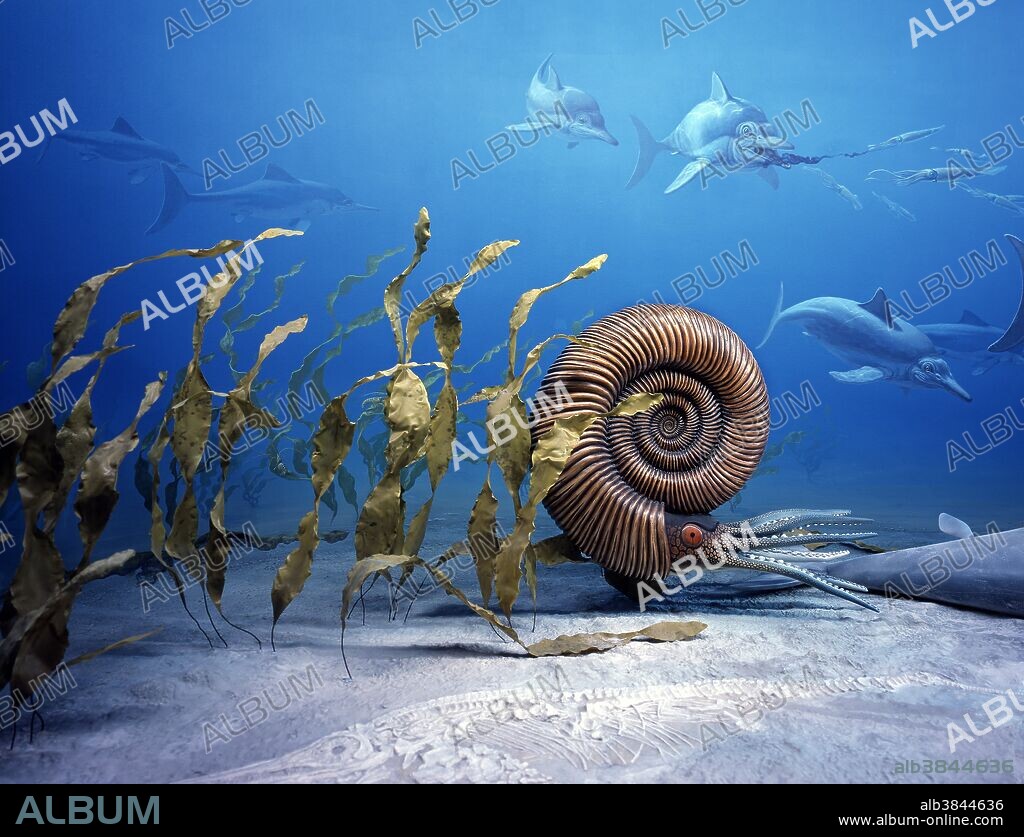alb3844636
Jurassic ocean

|
Añadir a otro lightbox |
|
Añadir a otro lightbox |



¿Ya tienes cuenta? Iniciar sesión
¿No tienes cuenta? Regístrate
Compra esta imagen.
Selecciona el uso:

Título:
Jurassic ocean
Descripción:
Ver traducción automática
Diorama: Jurassic ocean with ammonite (Titanites anguiformis, based on fossil from Portland, Dorset, England) and ichthyosaurs (Stenopterygius sp. based on fossils from Holzmaden, Germany). Coiled cephalopods, called ammonites, were common in Jurassic seas. They had gas-filled, chambered shells which allowed them to adjust their buoyancy while swimming. Jurassic ammonites over six feet in diameter have been found. Marine reptiles ruled the Jurassic seas. The ichthyosaurs (school shown in background and skeleton in substrate) superficially resembled modern-day dolphins. Their vertical tail fin gave them the fast maneuverability of a fish, and their stiff paddle-like limbs gave them good steering and attitude control. Preserved stomach remains indicate that they fed on fish and cephalopods, like the squid-like belemnites in the upper right corner of the photo. Belemnites had a dense cigar-shaped internal skeleton of solid calcite, often preserved as fossils. The kelp-like algae to the left of the ammonite is hypothetical.
Crédito:
Album / Science Source / Chase Studio
Autorizaciones:
Modelo: No - Propiedad: No
¿Preguntas relacionadas con los derechos?
¿Preguntas relacionadas con los derechos?
Tamaño imagen:
5220 x 3999 px | 59.7 MB
Tamaño impresión:
44.2 x 33.9 cm | 17.4 x 13.3 in (300 dpi)
Palabras clave:
ALGAS • ANIMAL EXTINTO • ANIMAL • ANIMALES EXTINGUIDOS • ANIMALES • CEFALOPODO • CEFALOPODOS • DIORAMA • ERA MESOZOICA • EXTINCIÓN • EXTINGUIDO • FAUNA • FLOTA • FÓSIL • FOSILES • FOSILIZADOS • ILUSTRACION • ILUSTRADO • JURÁSICO • MAR • MARINA • MARINE • MESOZOICO O ERA SECONDARIA • MODEL • MODELOS • NADAR • NATACION • OCEANO • PAISAJE DEL MAR • PERIODO JURASICO • PINTURA • PINTURAS • PREHISTORIA • PREHISTORICO • RECONSTRUCCION • RECONSTRUCCIONES • SEA
 Pinterest
Pinterest Twitter
Twitter Facebook
Facebook Copiar enlace
Copiar enlace Email
Email
